Cityscapeeast
in Berlin,01052004-06052005
This lecture was presented in 66
east, Centre for Urban Culture, Sumatrastraat 66 Amsterdam
,
februari 26, 2005
Ladies and gentleman on behalf of Buro jan-ZE and 66 east I welcome
you to this talk on the cityscapeeast project. This project is about changes
in the public domain of urban landscapes. I will take you were cityscapeeast
participants collected data for their works. So you will get a better idea
about what's shown here. I will take you on a expedition. Be prepared and
bon voyage.
The project started out in 1999 and concerned itself with the change in
eastern parts of town in North European cities.
Due to the dominant western wind in the North of Europe in the industrial
era these parts mainly used to be characterised by shipyards, stinking industry
and cheap working-class neighbourhoods. After the fall of the wall and in
the digital era there's a slow but unmistakable facelift taking place of
these citylandscapes.
Think of the Docklands in London, Tony Blair's milleniumtent which can be
now seen in the tv series Eastenders' introduction, trendy galleries are
opening their doors in Paris Est and last but not least: once a part of
East-Berlin is now Berlin-Mitte.
In Amsterdam large scale new-construction building took place. But had ideas
regarding the East actually changed?
The newly residential islands carry street names from the Indonesian Archipelago.
Even so, these so-called Eastern Islands are not included in the 'Indonesian
District'. For the East Indonesian District is part of East Amsterdam and
many new estate dwellers did not want that negative connatation.
As such, a North-South division occurred in East Amsterdam, the border being
the drainage canal. The North being the new estate and the South the poor
old part of town.
In the year 2000, on the occasion of the 100th anniversary of the Indonesian
District, the district council decided to place their neighbourhood in the
limelight. Cityscapeeast's first exhibition could begin. It was held at
the EYE adjacent to the drainage canal. The exhibition carried the title
howfareastistheindonesiandistrict? and was based on the concepts of velocity
of circulation and velocity of rotation.
I interviewed 120 people. 80% said that for them the centre of Amsterdam
is the DAM square with the palace of the royal family on it.
But how far east is the indonesiandistrict?
I calculated a shift in the topographical centre of the built-up area of
Amsterdam from 1914 up till 1999. (with the help of the Head of Mapping
of the University Library of Amsterdam. I draw a rectangle from the outmost
borders of building areas in Amsterdam and divided them) I did the same
thing from maps drawn in 1914). The topographical centre moved to the south
and a little to the east. If you look at it that way the Indonesian neighbourhood
migrated towards the topographical centre. (3 min)
Slide 1 map
I made a map with a reconstruction of a shift in the topographical centre
point where the neighbourhood had come from SOMETIME. The map is also showing
the discovery sites of garbage (take- a -ways) un earthed in Amsterdam east.
Slide 2 space model
From the garbage I reconstructed a model of a excavation of a futuristic
town plan. I referred to the evolution from garbage dump( once the destination
of this area) to yuppie-areas. In present dumping lay future raw materials
I never calculated the rotation speed Belt as you can see on the slide.
Slide 3 Golden rim
Netty Gelijsteen's contribution consisted of stamping a golden border. The
patterns were taken from the town plan and referred to the Arabic patterns
in (lace) curtains in the neighbourhood. Surprisingly enough, a similarity
seemed to exist.
The speed of rotation making the golden border: V ib was 4.6 cms per second
Michael Turnbull walked the outline of the former wall and has made acappella
songs of sounds of the public space on specific spots : the so called no-ones
lands. The pictures shown here will show you those spots through his eyes.
By using the same format for the songs the sounds are expressed in longitudinal
axis. The music plays inside your head and lasts for as long as you read.(
A kind of John Cage for deaf people. ( John cage made a piece for a piano
where the piano was silenced for 4 minutes and 33 seconds if I remember
it well. So you hear only the sound surrounding you.).
In the exhibition the public could mark the beginning of Amsterdam-East
on a map. Michael planned to walk along that border and compose Amsterdam
border songs as well. Due to illness this never happened. The drawing of
the border in 2000 is shown here. I would like to invite you to mark your
Amsterdam east crossingborderpoint on the new map. (3min)
Slide 4 space model. An image of the public space in the Indonesian District
Helena Koning, the architect, constructed a space model. Instead of designing
buildings she measures matter in relation to light. How the skies appears
to you depends on the angle of your eyes looking upward along walls.
Helena wanted to convert this experience into an objective calculation.
She designed the so-called urban factor: the height of the buildings divided
by the width of the streets. In the course of a hundred years much has changed
since the original town planning. Much new development has taken place.
The public domain changed frequently in those hundred years. This can be
seen in the model. After the intermission Helena will tell you all about
the urban factor.
Slide 5 the Dam in print
After the Indonesian district cityscapeeast took a trip to the PUBLIC centre
of The Netherlands as we regard the DAM, since all state ceremonies take
place there. Netty made a print of the DAM square paving just before Crown
Prince Willem-Alexander's wedding ceremony. Netty wanted to create a mobile
public centre, which would be accessible to everyone. During an important
ceremony, such as the wedding, the Dam is partly closed to the public. A
boundary arises between the private domain of the royal family and the people.
The dam was put into service at the White Square Fest. The mobile dam's
first exposition was a matter of record. Many followed. ( ask netty she
is present here)
Slide 6 garbage 270102
I made a waste landscape. Garbage on the dam, just before and after the
marriage was numbered, collected, photographed and incorporated in a sample
card. On slide the garbage before the wedding
Slide 7 vacuum cleaned DAM
After the wedding there was a partitioning in landscape and colour. In the
private part of the Dam, only accessible to the invitees, there were islands
of yellow and golden bits of paper.
Slide 8 golden litters
I have to admit that the royal family's invitees left quite a bit less garbage
than the people.
Slide 9 public side
The public part was a wave of garbage consisting of orange and red-white-and-blue
flags and bits of paper, orange coasters, orange shish kebab skewers, orange
crowns, orange balls, orange chairs, news papers and plastic bags that had
gathered against the fences.
Slide 10 outcropmap
Lide 11 sample card detail
The garbage was processed in sculptures
Slide 12 sculptures
You can see that our national waste product could easily be put in a OXFAM
art calendar.
We decided to bring the mobile dam and hence the mobile public centre of
The Netherlands to New York. After all we have a historical bond. Wasn't
New York founded by Dutch people? This time we didn't want to colonize or
annexe, but rather pull our weight (on cotton) regarding the discussion
on the historical event that had taken place on September 11th and it's
repercussions on the public domain in the urban landscape. At the same time
we would collect data in order to make new products.
In short, on oct 15 2002 the Dutch public mobile centre was rolled up and
stashed into a backpack.
Slide 13 installation new york Amsterdam
Netty donated on special locations fragments of the Dam as an alternative
ambassador. Six canvasses stayed behind in New York. One at the memorial
archive, one at Port Authority, one at the World Financial Centre. One canvas
was hung in St Paul's Chapel. The fire fighters received a canvas. At NINO's
American Kitchen a canvas is displayed in the window and finally a security
officer at Ground Zero took a canvas home. In the Netherlands a fragment
of the DAM is located at the Dutch WTC director's, at the councillor's of
inner city culture and in the IISG (International Institute for Social History).
The route that the mobile Dam took, is documented on video tape and reconstructed
in a installation(4,5min)
Slide 14 dam piece in dutch embassy
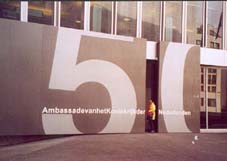
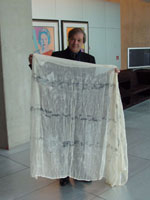 cultural attaché
in Berlin
cultural attaché
in Berlin
Back in Europe, Netty presented a "piece of the Dam" to the architectural
firm Libeskind in Berlin (said firm is partly responsible for the design
of rebuilding the WTC) and to the cultural attaché in the Dutch embassy
in Berlin. Slowly but surely the Dam is being spread over the world. Fortunately,
the Mobile dam is quite accommodating.
Because a quarter of the dam was displayed on may 4th 2004 in front of the
Reichstag. Netty held her commemoration of the death and for two minutes
there was silence.
Slide 15 commemoration of the death
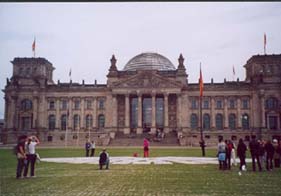

It was a weird experience to witness a commemoration in the former occupiers'
capitol. Although the Dam covered only a fraction of the lawn in front of
the Reichstag the DAM behaved as an equivalent.. Even better, it behaved
like the DAM: first people walked carefully around it:
Slide 16 jumping people dam in Berlin,
Subsequently people walked in between the dam fragments or tried to jump
over it, some took a seat. In the end Japanese tourists made pictures of
themselves on the dam with their backs turned to the Reichstag. The Reichstag
had taken the place of the monument.
But let´s return to New York for a while.
Silde 17 sampling garbage in New York
I sampled garbage on the spectators' bridge at Ground Zero and noted the
retrieval site on the map. There I was, amongst other disaster tourists.
The area was very clean. Garbage cans were situated on the left and right
hand side, with approximately 67 steps in between them. A few white cigarette
buts lay on the ground.
Slide 18garbage in can
What struck me was the American size of the garbage. What I mean is that
it was large per item. Ranging from cups to plastic covers for whipped cream.
On average it was larger than in Europe.
Slide19 refusal bag wtc area
The garbage cans were emptied at noon and again at 19.00 hours. Note the
special garbage bags used for the ground zero garbage district. The identity
which is adopted in the public domain and then discarded after the experience
in that public space was chiefly limited to coffee cups, MacDonald bags
and plastic water bottles. I made an interpretation on the map.
Slide 20 map left hand side
Where were the ruins of the WTC itself? What was left of it? That part was
most definitely privatised and behind a fence, but a fence on Staten Island
around Fresh Kills, the biggest garbage heap in the world, according to
the Americans. To dump the WTC heap of rubble fresh Kills hill 1/9 or the
Amsterdam mountain of live and death- had to be reopened. Because in the
near future fresh kills will become a public garden.
Netty and I found an opening in the gate. For our own piece of mind, we
asked permission from a couple of truck drivers.
Slide 21 fresh kills gate
A little nervously we started out on our journey. Soon we encountered Corey
Fsbarra, a welder, who was happy to show us around. According to Corey,
tourists had never before been interested in a garbage heap. We got into
his car that was full of beer cans.
Slide truckdrivers and corey
He showed us all kinds of interesting objects, varying from wild animals,
quick sand and draglines to a gas processing plant.
"I could commit a murder here," he said. "Nobody would know."
That heightened the tension quite a bit. And then suddenly we were at the
bottom of hill 1/9.
Slide 23 gate fbi
We passed a recently abandoned FBI village. After Corey had taken another
swig of beer and showed his ID we once again drove slowly upwards through
gates.
Slide 24 remains in bags, combed out and raked part.
In the distance we saw the Manhattan skyline, like broken teeth. It was
as if those teeth lay spread out in front of us. A sickly, sweetish, burnt
odour rose towards us. Ultimately we stood on a fine, brownish, sometimes
black, chewing gum like sludge that had been raked. It was all very bizarre.
Finally I had the feeling to have paid my respect to the people killed,
and after that I had fewer problems with my being at the WTC crater. (5min)
Slide 25 drawing cartoon
I draw a cartoonish account with a cross-section of fresh kills hill 11/9
as I imagine a future garbageheapologist would draw it. You can see a small
layer of unidentified strange matter.
Slide 26 details
Geologist found not that long ago a small layer of unidentified strange
matter. Until that time that layer had always been missed. They reconstructed
a meteorite that had sometime crashed on the Northern hemisphere and thus
wiped out dinosaur life.
Will this layer EVER change our view of the world, or rather consolidate
it in networks that nestle themselves behind the well guarded fences that
divide the public domain from the private.(1min)
We click to Berlin again.
I sampled leftovers near the former wall. The routes I took are expressed
in the drawings shown here in the gallery.
Everywhere I found gates, fences, borders and (blind) walls.
Slide27 fences berlin


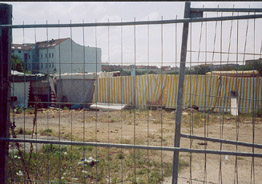
As if the old wall was splintered into different segments. Around the Dutch
embassy by the architect Koolhaas, were crush barriers and guards, while
the public space was supposed to continue into the transparent building.
The embassy stood there as a strange entity. Its rectangular stone and lightning
green lawns, its cut and sawed trees reminded me of a Japanese garden. It
had no longer anything to do with the concept of Koolhaas.
Slide 28 the Dutch embassy and the Jewish museum.
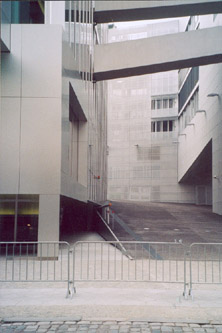
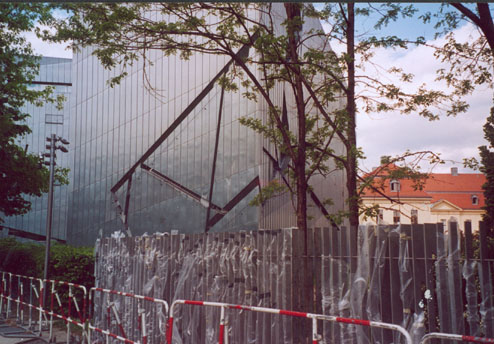
In front of the Jewish synagogue ribbons in red and white and armed forces
blocked the sidewalk. The Jewish. museum of Libeskind was also protected
by white and red ribbons.
Slide29 wall with wall
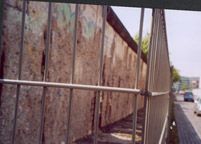
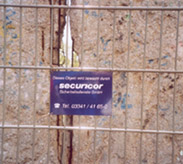 Slide 30security sign
Slide 30security sign
A wall protected even the former wall. And a security sign protected that
wall.
As if the public space has become a monster, that is on the prowl and
will eat us and against which we should protect our civilisation. The public
space has replaced the wilderness, like the cottage garden protected us
from sprawling, dangerous nature. We all know the story of Peter and the
wolf. The public space is acting as an untamed, dangerous wolf.
Slide 31 clearing out the grave of the wall.

But I also stumbled upon remains of the old wall herself. That what seemed
to be desirable once, lay partly buried on a cemetery.

Slide 32 dandelions and pink leaves
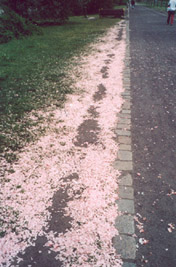
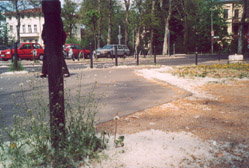
Much of the leftovers had a rural character. Like dandelions and pink
leaves or wood. It seems to me that Berlin always had a rural glow. Probably
due to the urban factor as Helena had explained to me, long wide roads and
relatively low houses. In contrast to the Potsdammer Platz , where Sony's
and other brand new buildings offer an urban image like everywhere. And
what to think of the shopping mall near Wusterhausen in the south east of
Berlin. The size of the estate made it impossible to get a good picture.
Apart from shops the building hosts discos, restaurants, movie theatres
etc. This alien in the midst of small

garden- and farmhouses and pastures awakened my desire to throw a bomb
on it. But I took refuge in a book.
I read Don de Lillo Underworld p 786(1)
Slide 33 mall

The old cabdriver who could hardly see anything, but because of the wende
had found himself a new job, stated: Everything what I do not need or want
is for sale there and he pointed to the alien . I want my daughter and son
to be close to me, but there is unemployment here and they moved to the
west.
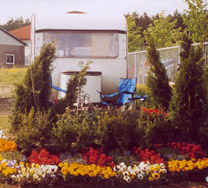

Slide 34 caravan.
Friend Herman offered resistance in his caravan. He sold Dutch flowers and
trees. The old woman who arrived on foot paid half the prize compared to
the man in the Mercedes. And he only paid half of what flowers cost in the
shopping mall.
Herman got water from the shopping mall storage guard. He drank his coffee
at MacDonald's, so he could take a hot shower along with it. He ate ethnic
fast food at the little stands of the new inhabitants, in the parking space
in front of the mall. (4min)
And like in a 3 dimensional woven texture, he and his allies contribute
to a under economy in a mall without which they could not survive
Is it really true that the public space is getting more and more divided
in fragments which nestle themselves behind the well guarded fences.I quote:
the more we feel connected the more free we feel. It states a lot about
our understanding of freedom nowadays. (Henk Oosterling in "easycity".
pg 80. The translation is mine).(2)
He meant the gsm cars, internet laptops and mobile phones with which
you can create your own private Idaho anywhere. Does the public space loose
terrain? Do we see it just as a transfer space, to get as quickly and as
anonymously as possible from one private space to another? One can also
state the opposite. What was private once becomes more and more public.
I do think that some recognizable similarities(recognizable tokens of identity)
are more accepted in the public space than others. Headscarves and skullcaps
are not accepted, but nikes, expensive sunglasses and turbans are.
Street robbers are not, but a white collar criminal as prins Bernard is
extendedly displayed in the public space. Dead of course. The accepted public
space condition for robbers is a dead condition.(3)
In Berlin on May 1 st the street was crowded with tanks, police cars, water
guns encircling the square. People on the oranienplatz celebrated May 1st,
drinking beer, others just ate on the terraces, impassive or walked their
dogs across the troops. As if all the green was simply not there, it all
mingled and none would be provoked or got scared. A turn in the celebration
of May 1st.
Slide 35, green on the street.
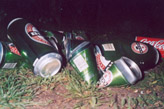
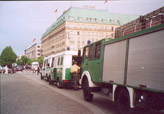
And the public space itself? In the Indonesian district it has increased,
I think. There are squares, green lawns, parks and water. Is this because
nowadays it takes too long to get out of the city?
Let us return to the urban factor. Helena still looks at the sky She
calculated at length at this very complex area in New york, which differs
enormously per plot.
Slide 36 New York keep your head in upright position
The outcome offers us a different way to talk about public space. It
offers a possibility to find a more neutral language, which doesn't have
it's origin in fear and enemy images. Such as: "we have to have very
high buildings, otherwise the terrorists will have won". But it enables
us to talk about what we want a city to look like.
After the break Helena will tell you all about the urban factor. I thank
you for your attention.(4 min)
Slide 37 holiday berlin opening in wall. Break slide
(1)I quote: And the system pretends to go along, to become more supple
and resourceful, less dependent on rigid categories. But even as desire
tends to specialize, going silky and intimate, the force of converging markets
produces an instantaneous capital that shoots across horizons at the speed
of light, making for certain furtive sameness, a planning away of particulars
that effects everything from architecture to leisure time to the way people
eat and sleep and dream. End of quote. Don de Lillo Underworld p 786
2. Easycity. Interventies in en verscheurde stad, De vrije ruimte, juni
2004
3.66 east is sutated in the SW quadrant of the Indonesian District of
Amsterdam. It was very close to the place where the murder of van Gogh took
place and where a thief was killed trying to get a purse out of a car.I
experienced a big contrast in images in the media about Amsterdam east and
the encounters I had in the public space in front of the gallery . I threw
snow ball with the little children from arabic origin. I had discussions
with people from all over the world: Surinam, Marrocco, Turkey and Ghana.
In summer time I showed the Javastreet, which lays just around the corner,
to friends. I called it little Manahttan because it reminded me of New York.
A busy street, filled with live, trade and summer noises.
Of course also bad things happened. When I made pictures, in preparation
of the workshop in 66 east where I would draw the Javastreet, I was atatcked
by an angry young man. He thought that he owned the public space and that
he had to protect his sisters and his friends from me taking pictures. He
was afraid of what I was doing in front of his shop. He saw me as an ennemy,
while I was only taking pictures of bycicles. It made me afraid and sad.
Sad because it reminded me of my own youth in such a simular hood.In that
time there where no moslims or christians or whatever. There was simply
the hood with christians and no christians, with lefts and rights, laborars
where good and bosses where bad and not thrust worthy, in fact everybody
outside was a potential enemy. If you keep your head in such a hood and
think of yourself as Robin Hood you will only see a very small, small world.
Throw off that hood and look more closely and you will encounter a big world
of variations just on the sidewalk in front of your house.

 cultural attaché
in Berlin
cultural attaché
in Berlin







 Slide 30security sign
Slide 30security sign








